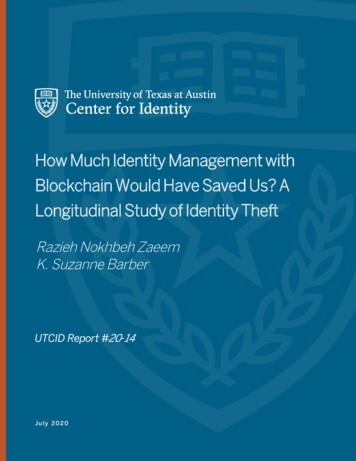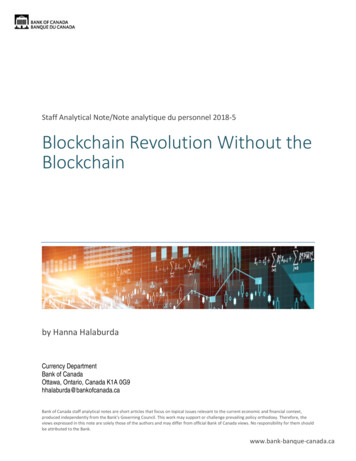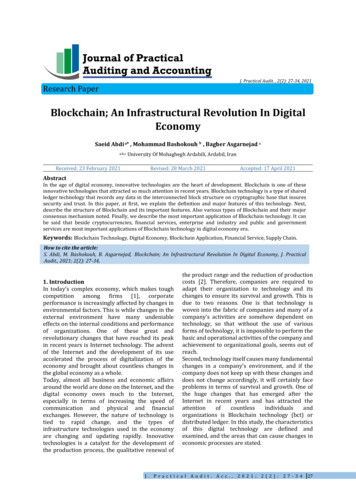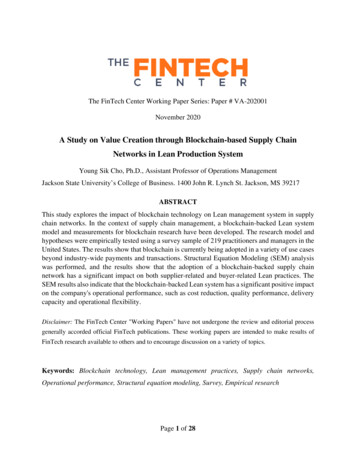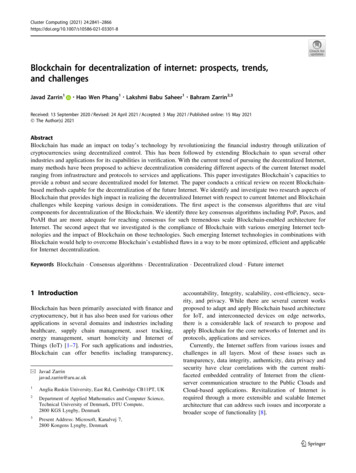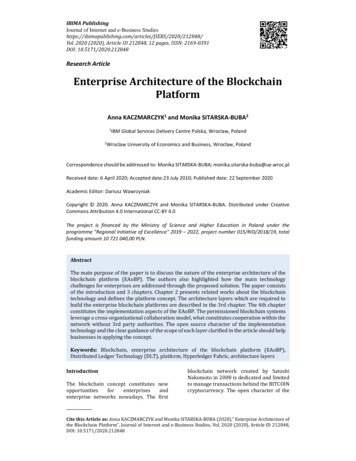
Transcription
IBIMA PublishingJournal of Internet and e-Business 2020/212848/Vol. 2020 (2020), Article ID 212848, 12 pages, ISSN: 2169-0391DOI: 10.5171/2020.212848Research ArticleEnterprise Architecture of the BlockchainPlatformAnna KACZMARCZYK1 and Monika SITARSKA-BUBA21IBM Global Services Delivery Centre Polska, Wroclaw, Poland2Wroclaw University of Economics and Business, Wrocław, PolandCorrespondence should be addressed to: Monika SITARSKA-BUBA; monika.sitarska-buba@ue.wroc.plReceived date: 6 April 2020; Accepted date:23 July 2010; Published date: 22 September 2020Academic Editor: Dariusz WawrzyniakCopyright 2020. Anna KACZMARCZYK and Monika SITARSKA-BUBA. Distributed under CreativeCommons Attribution 4.0 International CC-BY 4.0The project is financed by the Ministry of Science and Higher Education in Poland under theprogramme "Regional Initiative of Excellence" 2019 – 2022, project number 015/RID/2018/19, totalfunding amount 10 721 040,00 PLN.AbstractThe main purpose of the paper is to discuss the nature of the enterprise architecture of theblockchain platform (EAoBP). The authors also highlighted how the main technologychallenges for enterprises are addressed through the proposed solution. The paper consistsof the introduction and 3 chapters. Chapter 2 presents related works about the blockchaintechnology and defines the platform concept. The architecture layers which are required tobuild the enterprise blockchain platforms are described in the 3rd chapter. The 4th chapterconstitutes the implementation aspects of the EAoBP. The permissioned blockchain systemsleverage a cross-organizational collaboration model, what constitutes cooperation within thenetwork without 3rd party authorities. The open source character of the implementationtechnology and the clear guidance of the scope of each layer clarified in the article should helpbusinesses in applying the concept.Keywords: Blockchain, enterprise architecture of the blockchain platform (EAoBP),Distributed Ledger Technology (DLT), platform, Hyperledger Fabric, architecture layersIntroductionThe blockchain concept constitutes newopportunitiesforenterprisesandenterprise networks nowadays. The firstblockchain network created by SatoshiNakomoto in 2008 is dedicated and limitedto manage transactions behind the BITCOINcryptocurrency. The open character of theCite this Article as: Anna KACZMARCZYK and Monika SITARSKA-BUBA (2020)," Enterprise Architecture ofthe Blockchain Platform", Journal of Internet and e-Business Studies, Vol. 2020 (2020), Article ID 212848,DOI: 10.5171/2020.212848
Journal of Internet and e-Business Studies2network and the anonymous character ofthe peers made the business usability of theblockchaintechnologyquestionable.Despite the business weaknesses, theconcept was so promising that many of theauthorities concluded it as disruptive forbusiness models and processes nowadays,(Risius, 2017 and Beck, et al. 2017). Hugecommercial potential industrieslikeAmazon, IBM, Microsoft Azure, HewlettPackard, Oracle and SAP started working onthe new technology (Onik, et al. 2019). In ashort time, the blockchain has beengeneralized to the distributed ledgersystems that process all types oftransactions within the network far beyondcryptocurrencies (Swan, 2015, SitarskaBuba, 2018, Wörner, et al. 2016 andHofmann, 2018).Blockchain is not a completely newtechnology, it is rather just a newmechanism utilising existing multifacetedtechnologies together – such as distributedledger technology (DLT), mathematicalhashing, distributed networks, asymmetricencryption techniques, digital signaturesand programming (Onik, et al. 2019 andBadr, et al. 2018). The Blockchaintechnology brings the possibility to embed across-organizational collaboration model, (joining entities that already cooperate intochains, and eliminating redundancy oftransactions storage through a commondistributed ledger (Norta, 2016).The goal of the article is to present theenterprise architecture of the blockchainplatform and highlight how maintechnology challenges for enterprises areaddressed through the proposed solution.Chapter 2 presents related works about theblockchain technology and defines theplatform concept. The architecture layerswhich are required to build the enterpriseblockchain platforms are described in the3rd chapter. The 4th chapter describes theimplementation aspects of the EAoBP.Blockchain Technology and PlatformConceptThe first generation of blockchains, whichwere public (permissionless), consists ofdistributed nodes working together in apeer-to-peer model (e.g. Bitcoin, Ethereum).Anyone can join and leave the publicblockchain ecosystem at any time, enjoyingthe full access to read and write (Onik, et al.2019). Blockchain systems operate underthe governance model to build trustbetween participants on a shared network.(Wu, 2019). Each participant’s (node) hasequal rights in approving the transaction.The transaction is an elementarycomponent of the Blockchain system. Thismodel rejects the creation of a centralauthority needed to approve thetransaction.Theauthenticationisprocessing within the network by eachnode. The transaction is asymmetricallyencrypted and marked with a one-way hashfunction, which is collision-resistant andirreversible (the transaction cannot beplayed back, knowing only its shortcut).The new transaction is transmitted into theblockchain network, which means that eachnode receives information about adding anew entry at the same time, in order toeither confirm or reject it. The decision toadd a new block should be madeautonomously by each of the nodes basedon the accepted consensus mechanism (e.g.Proof of Work (PoW), Practical ByzantineFault Tolerance (PBFT)). If a consensus isreached, the new block is added to thecurrent system. A newly added block willstore the hash of the previous block, whichallows to keep the data structure in thesystem.The introduction of smart contracts startsthe second generation of blockchainsystems (Blockchain 2.0). Smart contractswere introduced as semi-autonomousprograms running on the blockchain.(Omohundro, 2014). The consensus isimplemented in the form of smart contracts,which are programmable rules/codesallowing transactions to result from theexecution of user-defined programs (Rimba,et al. 2018). Moreover, smart contracts areresponsible for ensuring that all newtransactions are compliant with the agreedconsensus. (Tschorschet, al. 2016). It evenallows parties who do not fully trust eachother to conduct and reliably control mutualtransactions without relying on the servicesAnna KACZMARCZYK and Monika SITARSKA-BUBA, Journal of Internet and e-Business Studies,DOI: 10.5171/2020.212848
3Journal of Internet and e-Business Studiesof any trusted middle men (Rimba, et al.2018). Smart contracts cover the agreedconsensus within the network businessrules and business agreements, and areused to build trust within the network.Only the smart contracts implementationenabled the embedding of crossorganization collaboration models erated(hybrid/consortium) blockchains. In theprivate blockchain, the access is restricted,and read and write access are controlledbased on the roles of the nodes or otherrestrictions as defined by the protocol(Onik, et al. 2019). The Federatedblockchain is moderated according to theconsortium need, the access can berestricted, or reading/writing rights will belimited and defined as prioris. The flexibilityproposed by the federated blockchainscreate the optimal environment to buildcross-organization collaboration models,addressing real business needs.The synergy effect of usage in well knowntechnologies like DLT, mathematicalhashing, distributed networks, asymmetricencryption techniques, digital signaturesand programming makes it possible tocreate a new generation of IT systemscharacterized by features like immutability(resistance towards the modification ofdata) and non-repudiation. Systems arealso forgery resistant; certain researchersbelieve that even quantum computers arenot able to change transactions (process thefraud) withina distributed network(Singhal, 2018). Public blockchain systemsare fully democratic, which allows to createa Regulator role or build internal channelsto limit the transaction exchange within(HF01 2020). The way a data structure isdefined and data are stored, blockchainsystems are double-spent resistant.Another very important feature of theblockchain technology is the consistentstate of the ledger which is achievedthrough implementingthe properconsensus mechanism (Singhal, 2018). Ifthe ledger is consistent and immutable, thewhole system is auditable, because alltransactions (past and current) are stored.The peer-to-peer processing makesblockchain systems resilient. Even if a singlenode is lost, the security and consistencywill not be threatened because the sameledger copy is stored by all other nodes.On top of the above described features, theblockchain technology enables digitaltokens to be distributed around thenetwork participants. In the Blockchainworld, tokens have emerged as the artefactof choice to represent assets, a utility or aclaim on something inherent to a specificblockchain project. Tokens exist due to theirusefulness of representing somethingdigitally (Pilkington, 2015 and Oliveira, etal. 2018). Researchers identify three maintypes of tokens: cryptocurrency, utilitytokens (used as an internal paymentmethod, a reward for reaching a consensus,a workload performance reward, a votingright confirmation or as a digital asset) andtokenised security (equity or fundingtokens). The equity token grants its holderequity-related earnings, such as profitsharing, application rents or platform fees,and the funding tokens are defined in theinitial coin offerings (ICOs) process torepresent a long-term investment from theholder’s perspective and a financing vehiclefor the project’s team (Oliveira, et al. 2018).Cryptocurrency and utility tokens aremostly used in permissionless blockchains,where the lack of trust nudges themtowardstheplatform’sdistributedconsensus (Lewis, 2015). In opposition tothat, the permissioned blockchain lacks theneed to issue tokens out of a mere choice orpure funding aspirations (Blockchain Hub,2017, and Lewis, 2015). Before theimplementation of any tokens withincommercial (permissioned) blockchainsystems, their usage and business valuesshould be discussed first.There are several limits identified for theblockchain technology that have to beaddressedduringthebusinessimplementation. According to the authors,the most critical limits are the transactionthroughput and the transaction latency. Forthe bitcoin, the average transactionthroughput (number of transactionsprocessed per second) is between 3.3 and4.8 TPS (Blockchain, 2020, Croman, et al.2016 and @wandererli, 2019). Compared toAnna KACZMARCZYK and Monika SITARSKA-BUBA, Journal of Internet and e-Business Studies,DOI: 10.5171/2020.212848
Journal of Internet and e-Business Studies4the payment systems, like Visa, where thereis around 2000 TPS rate, as Croman, et al.(2016) mentioned, it is clear that the bitcoinwill not replace the payment transactionsystems. Transaction latency can beunderstood as the time needed to add a newtransaction within the system. The latencytime is dependent on the consensusmechanism implemented in the network. Inthe Bitcoin chain, where the PoW consensusis implemented, 10 minutes are needed toadd a new block to the system. Blocks arerelatively small, around 1MB (@wandererli,2019). So, huge latency is not acceptable intransaction systems, which means that thescalability of the system is questionableaccording to the business usage.Technology itself will not help developersbuild blockchain based systems. Scientistsemphasize that the industry should alsoprovide a platform, that is considered asthe development framework to createmultiple applications (Pillai, et al. 2017).Developers should be able to write theirown application codes using specificcomponents of the platform. Not onlytechnicalchallengeslikesecurity,performance, data integrity, privacy andscalabilityshould be addressed (YliHuumo, et al. 2016), but also quality aspectsshould be taken into consideration likeusability for developers and suitability forthe integration within the network (Pillai, etal., 2017).Enterprisearchitectureofblockchain platform (EAoBP)theThis section proposes the enterprisearchitecture of the blockchain platform indetails, presenting all the required layers.The limits of the blockchain systems,described in the previous chapter, made thepure architecture not implementable in theenterprise environment. Based on theresearch, the following requirements needto be considered for the enterpriseimplementation of a Blockchain network:Participantsmustbeidentified/identifiable – the enterpriseusage of the Blockchain platform requiresthe participants to be fully identifiable tokeep the transaction trustworthy without a3rd party authorisation.Networks need to be permissioned – inthe business reality, the network is not openfor everyone. It is limited to the identifiedparticipants who were invited to be part ofit. The permission mechanism should beeasily implementable.Hightransactionthroughputperformance - one of the weaknesses of thepublic networks is the transaction executiontime, which can take up to 10 minutes toprocess a single transaction (@wandererli,2019). There must be a condition toimplement the acceptable transactionexecution time.Low latency of transaction confirmation– each transaction should be confirmedwithin the blockchain network as soon aspossible. Delays or too high latency lead tolow efficiency of the network and loss oftrust by ns and data pertaining tobusinesstransactions–enterprisenetworks will not share their dataworldwide, they will require their data tobe kept private and confidential within andoutside the network(as mentioned in IBM 2020, Forrester 2018and HF02 2020).The authors defined the enterprisearchitecture of the Blockchain platform thatmeets the business requirements and traysto address the constrains and limits of thepublic blockchain network (Fig. 1).They proposed the Blockchain 2.0 systemarchitecture, which consists of five layers.Each layer plays a different role and isresponsible for the execution of a specificfunctionality that determines Blockchain2.0 as a whole (Singhal, 2018). The authorsagree that the application, execution,semantic, propagation and consensus layersare critical to build a blockchain platform.The application layer is responsible for thecommunication with the end-users,providing them with specific businessAnna KACZMARCZYK and Monika SITARSKA-BUBA, Journal of Internet and e-Business Studies,DOI: 10.5171/2020.212848
5Journal of Internet and e-Business Studiesfunctions and IT services, and allowingthem to process transactions in accordancewith the defined business rules. Due to thepeer-to-peer processing model, therecommended development/programmingframeworks are those which allow to createapplications hosted on the web servers,where new features are developed at theserver level and the communication withusers is managed through API. Moreover,applications should support a properidentity management and a workflowmanagement.The execution layer is responsible forexecuting the instructions that are called bythe application layer. The same set ofinstructions must be executed by each nodeindependently to claim a new transaction.Through instructions, single scripts,algorithms or programs such as smartcontracts are understood. The deterministicexecution of a specific instruction on thesame input dataset and under the samerestrictive conditions always provides thesame output dataset for all nodes. Thessfeatures of the blockchain technologyensure data consistency, immutability andtrust within the distributed ledger.The semantic layer defines the logicalstructure of the blockchain system. Eachtransaction, correct or not, is processed atthe execution layer. The semantic layer isresponsible for the validation, andconsequently, the approval or rejection ofthe transaction in the system. The semanticlayer constitutes the definition oftransaction’s validation rules, data modelsand data structure. In general, theblockchain structure is a timestamped list ofblocks, where blocks are connected througha hash function (Wörner, et al., 2016). Itmeans that data are hash pointers thatencrypt transactions of a given block. Eachblock stores its hash function andremembers the hash function of itspredecessor up to the generic block(Drescher, 2017). At the semantic layer,system developers implement smartcontracts,whichareautonomousalgorithms or mini-programs performingadditional operations written in their codesduring the transaction execution (Klinger, etal., 2017). The extensive use of smartcontracts allows for the creation of newvirtual goods that constitute a businessvalue in a specific Blockchain system.The propagation layer is responsible forthe definition of communication andsynchronization within the blockchainplatform. The blockchain network is a peerto-peer network, where each node isautonomous and there is no centralauthority approving the transactions. Forthe public chain, it is necessary to ensure thevisibility of all nodes in the chain as well asthe rules for adding new nodes so that theybecome equivalent members in thenetwork. The next step is to manage thesynchronization process between nodes. InBitcoin blockchain, when the new block isgenerated, it is immediately validatedwithin the entire network. If this blockpasses the correct validation, it issynchronized throughout the network.Transaction throughput and latency are themost critical weaknesses of the public chainthat make a business value of the wholesolution questionable.For example, this issue has been addressedin Hyperledger Fabric by dividing theworkload of the nodes between endorsingand committing peers and transactionordering nodes, which will be furtherdiscussed in chapter 4 (HP01 2020).Another positive deviation in private chainsis the possibility to create a role of a centralauthority (regulator), whose approval willconfirm the creation of a new transaction inthe network. There are business models,especially in the government area where aregulator is needed but all other blockchainfeatures can be used to create an addedvalue for the network participants.The consensus layer is the most importantand basic layer to meet the generalassumption of the blockchain technology.This layer defines the consensus on thebasis of which transactions or blocks withinthe entire network are approved. The basicgoal of each blockchain network is toachieve a consistent state of the ledger. Eachblockchain system may implement andexecute a different consensus algorithm, butfor the assumption, the result is to validateAnna KACZMARCZYK and Monika SITARSKA-BUBA, Journal of Internet and e-Business Studies,DOI: 10.5171/2020.212848
Journal of Internet and e-Business Studies6implementation of shared businessprocesses, additional aspects affecting thearchitecture must be considered. Theauthors propose to extend the traditionallist of layers through permission, dataprivacy and integration layers. Theenterprise architecture of the Blockchainplatform is presented in figure 1.one common version of the registry withinthe network without the participation of thecentral authority. The security, trust andimmutability of a given network isdetermined by the effectiveness of theconsensus algorithm.For the commercial usage of ission LayerApplication LayerExecution LayerSemantic LayerPropagation LayerIntegrationLayerConsensus LayerBC transactionsBC transactionsPrivacy Data LayerPermission LayerEnterprise XOrganization BEnterprise ABC transactionPrivate transactionBC transactionBC transactionBC transactionPrivate transactionEnterprise CBC transactionPrivate transactionBC transactionPrivate transactionPrivate transactionBC transactionPrivate transactionBC transactionBC transactionPrivate transactionPrivate transactionFig. 1: Enterprise architecture of the Blockchain platform (EAoBP)Source: own research, based on (Sitarska-Buba 2018)EAoBP will be mostly dedicated toparticipants of the business networks thatalready cooperate. They have a need tocreate a distributed transaction ledger andshare their business results within thenetwork. To meet this request, the authorsdefined a permission layer that isresponsible for the definition of the accessrules for network participants. The businessentity will be allowed to access theblockchain network only when otherparticipants agree or based on invitationsonly. The way the permission layer will beautomated is up to the business agreementsbetween the current participants. There areexamples of the Blockchain implementationwhere the networks are fully private, as inthe following polish cases: Durable Medium,KIR and e-Voting, KDPW. Those examples,further described in the next chapter,confirmed the need for a permission layerdefinition. The implementation of thepermission layer can be executed intraditional contracts signed betweenAnna KACZMARCZYK and Monika SITARSKA-BUBA, Journal of Internet and e-Business Studies,DOI: 10.5171/2020.212848
7Journal of Internet and e-Business Studiesindividual companies or implemented in ablockchain code.transaction and distribute them around thenetwork based on the data privacy protocol.The permission layer has also beenhighlighted at the end-user level. It is thenatural consequence of the closed access fornodes that is further distributed toapplication users . If the blockchainplatform is private, the access for the usersis private as well. The access could begranted based on the invitation that has tobe confirmed by the authority within thechain or by the network itself. In the secondcase, the invitation code could use aconsensus mechanism that is alreadyimplemented and manage each access as aspecific type of the transaction.Implementation of the EAoBP based onthe IBM Blockchain platformGoing deeper into the blockchain platformlayers, the authors identified the dataprivacy layer that provides participantswith the possibility to identify and limittransactions that will be processed withinthe blockchain system (on-chain and offchain distribution) (Xiwei, et al., 2016 andXiwei, et al., 2017). This requirement is notonly related to the data privacy regulationdefined by the European Union (GDPR).This layer was created to ensure theflexibility for participants to define anaccess level for a specific type oftransactions exchange between nodes. Forexample, Hyperledger Fabic v.2.0 provides aprivate data collection mechanism whichallows to exchange specific data onlybetween a priorly defined nodes. Peer-topeer data distribution is still used but nodessend transactions only to the organizationthat is authorized to see them (HF01 2020).Enterprises that decided to createblockchain platforms usually build themabove other IT systems and platforms thatalready exist in their organizations.Different backend systems, frontendplatforms and data hosting environmentshave contributed to define the integrationlayer. This layer is responsible for workingout a common technology platform wherenodes will be hosted and maintained.Within this layer, the nodes will create theintegration code responsible for thetransaction extracted from the internal ITsystems, translate them into a blockchainThe authors decided to present theimplementation example of the EAoBPbased on the IBM Blockchain platform andHyperledger Fabric v2.0, which is an opensource blockchain framework designed forbusiness.The main reason for this choice was that theResearch Everest Group assessed IBMBlockchain Services as a Leader in a field of30 service providers in the BlockchainServices (PEAK Matrix Assessment 2020).Everest specifically noted IBM's strength inthe integrated services and solutions, theglobal delivery footprint and the vastnetwork of partners across differentindustries, and the ability to consortiacooperation and governance (Doshi, et al.,2019).IBM Blockchain platform is integrated withthe Hyperledger Fabric framework. TheHyperledger or the Hyperledger project thatstarted in December 2015 is an open sourcecollaborative effort created to advancecross-industry blockchain technologies. It isa global collaboration, hosted by the LinuxFoundation, including leaders in finance,banking, Internet of Things, supply chains,manufacturing and Technology. TheHyperledger Fabric was the first of theHyperledger projects. The cooperationbetween IBM and Linux Foundation was soefficient because Hyperledger Fabricenterprise-gradepermissionedadistributed ledger technology (DLT)platform, designed for use in enterprisecontexts (HF02 2020). The permissionlayer is an integrated part of the solution,where all participants are well known andauthorized to be part of the consortium.Entities that are part of the network withcommon business goal, cannot trust eachother, therefore consensus mechanisms likecrash fault tolerant (CFT) or byzantine faulttolerant (BFT) are provided.RAFT is a crash fault tolerant (CFT) orderingservice based on an implementation of RaftAnna KACZMARCZYK and Monika SITARSKA-BUBA, Journal of Internet and e-Business Studies,DOI: 10.5171/2020.212848
Journal of Internet and e-Business Studies8protocol. Raft follows a “leader andfollower” model, where a leader node iselected (per channel) and its decisions arereplicated by the followers (HF03 2020).RAFT consensus is highly recommended byHyperledger Fabric these days.A significantly processing transactionincreases the overall performance of theplatform. Based on the newest resultspublished by (Gorenflo, et al., 2019), theplatform is able to support up to 20000transactions per second (TPS).The Data Privacy layer is provided byHyperledger Fabric through a channelarchitecture and a private data featurementioned in the previous chapter. Usingthe channels, participants of the networkcan establish a sub-network (private datacollection) where members can see aselected set of transactions. The privatedata collection allows data exchangebetween selected members of a channel,providing the same protection as channelswithout the need of creating andmaintaining a separate channel (HF022020).The Hyperledger Fabric is ready to use adevelopment framework that providesimplementable modules for each blockchainsolution like:Consensus, semantic, propagation andexecution layers are constituted by a smartcontract’s implementation and an executeorder-validateapproach.Chaincodes(smart contracts) are processed accordingto a new sequence (HF02 2020):Execute a transaction and check itscorrectness, thereby endorse it,Order transactions via a consensusprotocol, ic endorsement policybefore committing them to the ledger.The predefined endorsement policyspecifies how many nodes are needed tomeet the consensus or how many areneeded to vouch for the correct execution ofa given smart contract. The endorsementpolicy is defined for each specific blockchainnetwork, which means that the channelarchitecture, channel leader election rulesand the regulator role are establishedseparately. This rule brings us to theposition that each transaction needs to beexecuted (endorsed) only by the subset ofthe peer nodes necessary to satisfy thetransaction’s endorsement policy. Thisallows for a parallel execution, increasingthe overall performance and scale of thesystem (HF02 2020).Ordering service establishes a consensuson the order of transactions and thenbroadcasts blocks to peers,Membershipserviceproviderisresponsible for associating entities in thenetwork with cryptographic identities,An optional peer-to-peer gossip servicedisseminates the blocks output by orderingthe service to other peers,Smart contracts (“chaincodes”) run withina container environment (e.g. Docker) forisolation,The ledger can be configured to support avariety of DBMSs,Endorsement and validation policyenforcement that can be independentlyconfigured per application (HF02 2020),This is the perfect example of the EAoBPapplication layer.Creating a new blockchain solution by IBM,provides an integration layer that helps tointegrate data transformation and businessservices within cloud, on-prem or hybridenvironments.To create an effective blockchain solutionfor a business, there are at least three musthave conditions defined by IBM. First of all,the group of enterprises should have a realbusiness problem that can be addressedonly through a blockchain based system.The Blockchain ecosystem requires buildinga network of organizations that areinterested in resolvingthis businessproblem. The last condition is a need of trustthat has to be created by the blockchainsystem. Taking the above conditions intoconsideration, IBM successfully implementthe blockchain solution in different businessareas proving the efficiency and the futurenecessity of the technology.Anna KACZMARCZYK and Monika SITARSKA-BUBA, Journal of Internet and e-Business Studies,DOI: 10.5171/2020.212848
9Journal of Internet and e-Business StudiesFood Trust is one of the most successfulblockchain projects from IBM. It is a foodsupply chain based on the blockchaintechnology. It was designed as a private,permissioned blockchain network formonitoring food supply from farms toconsumer baskets. As early as 2016, BigBlue and Walmart began testing theblockchain technology to reduce the time oftracking goods. A proof of the concept wasdone by the Tsinghua University of Beijingfocusing on China’s massive pork market, itwas found that the tracking time reducedfrom days to minutes. The result is acustomizable suite of solutions that canoptimize the process of distribution,monitor food safety and freshness,m
Cite this Article as: Anna KACZMARCZYK and Monika SITARSKA-BUBA (2020)," Enterprise Architecture of the Blockchain Platform", Journal of Internet and e-Business Studies, Vol. 2020 (2020), Article ID 212848, DOI: 10.5171/2020.212848 Research Article Enterprise Architecture of the Blockchain Platform Anna KACZMARCZYK 1 and Monika SITARSKA-BUBA 2


